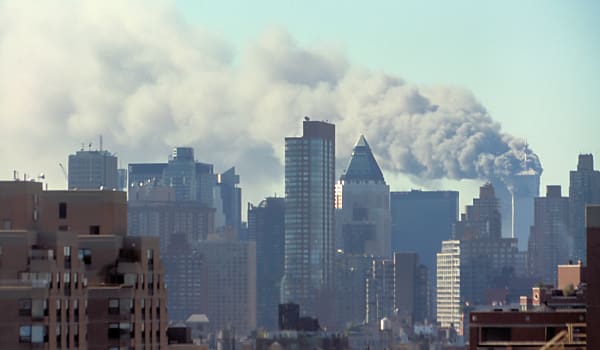World Trade Center Asbestos
Some of New York City’s World Trade Center buildings had asbestos. In fact, records show up to 2,000 tons of asbestos-containing materials were used during construction. These materials included sprayed-on asbestos fireproofing.
Construction on the World Trade Center began in 1966 when asbestos in building materials was common. By the early 1970s, the city had banned spray-on asbestos fireproofing, and crews had stopped using it. But before that time, they had already used it on about 40 floors in the North Tower.
The collapse of the Twin Towers produced a toxic dust cloud filled with contaminants, including chrysotile asbestos fibers. The Environmental Protection Agency (EPA) tested the area over the following week. In more than one-third of the samples collected by the EPA, asbestos levels were higher than what regulators consider acceptable. Anyone who came into contact with fibers may have inhaled them, which can lead to asbestos-related diseases.
The toxic dust cloud spread across Lower Manhattan. In the years following the attack, research suggested the dust cloud had traveled anywhere from 1.5 to 3 miles away from the World Trade Center. But people also shared reports of dust and debris outside this radius.
Following the attack, the EPA began testing the air and settled dust. Dust and air samples were collected from September 11 to September 18, 2001. More than 25% of the samples contained levels of asbestos higher than 1%.
Days after the attack, the EPA announced that Manhattan’s air was “safe to breathe.” But the EPA later concluded it did not have the data to back this claim. This misstep on the part of the EPA may have led to unnecessary asbestos exposures in the aftermath of the attacks.
World Trade Center Asbestos Health Risks
The asbestos in the World Trade Center created many health risks. The Centers for Disease Control and Prevention (CDC) estimates the 9/11 terrorist attacks exposed as many as 400,000 people to toxins. Health effects include 9/11-related illnesses and cancers.
Some conditions, including many asbestos-related diseases, may take years to develop. As a result, some victims are just beginning to experience symptoms of asbestos exposure. Others may not have started to show symptoms.
9/11 and Mesothelioma
Malignant mesothelioma is a 9/11 cancer of particular concern because of the high levels of asbestos released during the attack. Asbestos exposure is the only known cause of mesothelioma.
The number of mesothelioma cases stemming from 9/11 is largely unknown. Mesothelioma has a long latency period, meaning the cancer may take 10 – 50 years to develop. As time passes, mesothelioma diagnoses caused by 9/11 are expected to continue to grow.
Manhattan residents impacted by the attacks are at risk of developing mesothelioma. Higher quantities of asbestos and long-term exposure may increase mesothelioma risk.
What Can You Do if You Were Exposed to 9/11 Dust?
People exposed to asbestos have an increased risk of developing mesothelioma. These people may take safety measures to improve the chances of early detection. Anyone exposed should:
- Notify their doctor of their potential asbestos exposure
- Document the time of exposure and any suspected exposure sources
- Understand potential asbestos-related conditions and their related symptoms
- Notify their doctor immediately if any symptoms present
- Maintain frequent checkups
Early diagnosis is associated with better outcomes in mesothelioma patients. After diagnosis, patients can seek treatment from specialized mesothelioma doctors.
Treatment Resources for 9/11 Victims
Individuals affected by the World Trade Center attack may be eligible for benefits. Some New York City cancer centers have programs for first responders and other victims. For example, Mount Sinai Medical Center offers a World Trade Center (WTC) Health Program.
The World Trade Center Health Program
The WTC Health Program was set up to help those suffering from 9/11-related conditions. The program offers specialized support services to 9/11 victims, including:
- Benefits counseling
- Health monitoring
- Mental health services
- Treatment
There are four member types eligible to enroll in the program:
- General responders
- Fire Department of the City of New York (FDNY) responders
- NYC residents
- Pentagon/Shanksville, Pennsylvania responders
By December 2023, over 87,000 first responders had enrolled in the program. Enrollees include:
- 17,058 FDNY responders
- 68,841 general responders
Victims can apply through the WTC Health Program website. The program covers a variety of illnesses and asbestos-related diseases. Coverage includes all types of mesothelioma.
Compensation for 9/11 Asbestos Victims
Federal and state governments have programs to help the victims of 9/11. These programs assist victims in receiving compensation to cover medical bills and other fees associated with their diagnoses.
9/11 Victims Compensation Fund
Congress established the 9/11 Victim Compensation Fund (VCF) for two main purposes, to:
- Compensate victims who suffer a 9/11-related injury or loved ones who lost a family member to a 9/11-related injury
- Protect airlines from litigation related to the 9/11 attacks
Victims filing a claim could not file a lawsuit against airlines or other parties related to the 9/11 attacks. The fund initially ran from 2001 to 2004. Around $7 billion was paid out to more than 5,000 families. Families who suffered the loss of a loved one and people injured during the attack received compensation.
In 2023 alone, the VCF awarded victims more than $1.8 billion. This contributes to a total of over $12.7 billion awarded by the VCF since its creation.
Victims and family members may have the right to file a claim. Claims require specific documentation and must meet certain deadlines.
Victims may also be able to file lawsuits against companies that manufactured asbestos products used in the World Trade Center complex. People should seek help from experienced lawyers as soon as possible. Asbestos attorneys can help clients understand their compensation options and file claims on their behalf.
Common Questions About the World Trade Center and Asbestos
- Did the World Trade Center have asbestos?
Workers used asbestos during the construction of the World Trade Center. In the North Tower, spray-on asbestos coated the steel beams up to around the 40th floor. Contractors stopped using the spray-on asbestos fireproofing in 1971 when the city banned its use.
- How much asbestos was in the World Trade Center?
Estimates suggest the North Tower had between 300 and 400 tons of asbestos. Other estimates put the total amount of asbestos used in the World Trade Center at roughly 2,000 tons. The Port Authority, which managed the project, originally had planned to use 5,000 tons of asbestos.
- How far did the dust cloud travel on 9/11?
The exact distance the dust cloud traveled remains unclear. However, low levels of dust were found as far as the Empire State Building, almost three miles away. Research suggests some toxins may have traveled more than 40 miles away from Ground Zero. The smoke plume reached nearly a mile high.








